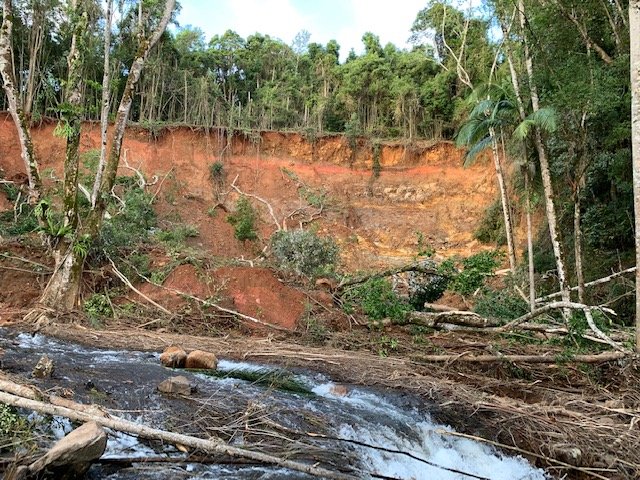flooding 2022
Written by Graeme Palmer
Looking back to the flooding in the Wilson River catchment of 2022, the announcement of efforts to formulate a solution to managing flooding, and the request to CSIRO to form an opinion, I have paused to think as well on this subject. Of course, as a business owner in the Lismore CBD, I am keenly interested in reducing the risk and losses that flooding presents.
There is no shortage of opinion on how civil works might be applied to the problem, and of course drains that skirt the town of Lismore would carry small volumes of water to the plains to the south, but the volumes that flowed in 2022 are so much larger than this infrastructure can manage. Indeed, the height of the Wilson river above sea at Lismore is just 4 m. This is about 3 cm fall per km of river to the sea at Ballina. The river height meter clearly shows it is tidal at Lismore. This implies that once water gets to Lismore there is not much that can be done but allow it to flow through to the flood plain and of course back up as the flood plain fills.
The alternative approach is to hold water higher in the catchment over the duration of the rain event allowing it to move and accumulate more slowly and enabling the channel through Lismore to manage the flow at less than catastrophic levels. How do you do that? If we put that aside for the moment and focus on what volumes and capacities we are talking about we can get a better view of the challenge.
To imagine the solution, we can consider a tall glass tube say 20cm diameter and 4m tall with a closed end at the bottom except for a smaller hole say 2cm in diameter. Let’ s also imagine at the bottom on stilts is a house representing Lismore. This house sits say 10 cm above the bottom of the glass tube. We then pour at constant flow rate, small volumes of water into the top of the tube that freely runs down the inside walls and out through the small hole. Normal river flows. Imagine we then poor water faster, and it can’t get out the small hole quick enough so accumulates inside the bottom of the tube. As the water rises, the pressure of water flowing out of the small hole increases flow and the level of accumulated water in the bottom stabilises under the height of our house. This is in a sense a raised river event not causing flooding.
Now we pour lots more water and the accumulation of water unable to get out the little hole rises until the house goes under. A simulated flood. Of course, making the hole in the bottom bigger would be a solution, but this can’t be achieved because the hole size is fixed by the flow rate of water over the very shallow fall in the flood plain.
Now let’s consider filling the bottom half of the tube with glass wool for example. Then we pour some water in. The water can’t flow directly to the bottom as it is held back by the glass wool. Water accumulated on top of the glass wool and way above the house at the bottom. Water continues to flow through the wool to the bottom, but unable to flow fast enough to flood the bottom of the tube.
Now lets consider this in practical terms. The catchment of the river above Lismore is around 1000 square kilometres. Worked out very roughly using Google Earth mapping. A reference in the Lismore City News estimated the water flow over the event in 2022 to be 250 billion litres. That implies a depth of 2.5m over the catchment area. If we could stall the flow such that this volume flowed over say 2 days, then at any time the depth of water over the whole catchment would be around just 5 cm.
So this presents an almost plausible solution, but how do we hold this much water in the catchment over 2 days.
Some ideas might be to impede flow in creeks at regular intervals with loads of rock that prevents fast flow but allows normal flow under normal conditions. Establishing vegetation and in particular forest trees on the banks of all the water courses to impede flow into to creeks. I can imagine that additional vegetation may well reduce the volume of sediment that comes down the river, and that might contribute to a large reduction in water level independent of rain. Installing temporary weirs that hold larger volumes behind small dams that can be opened during normal conditions.
There may be other appliances that could work too, but my imagination is limited.
Incidental to this is of course a cleaner river that might support greater tourism. Possibly an annual rowing regatta. There is the substantially increased production of wood that could support wood products manufacturing. There is the potential to hold water during drought improving the resilience of agriculture in an environment of changing climate.
What might be if we could only agree to organise.


